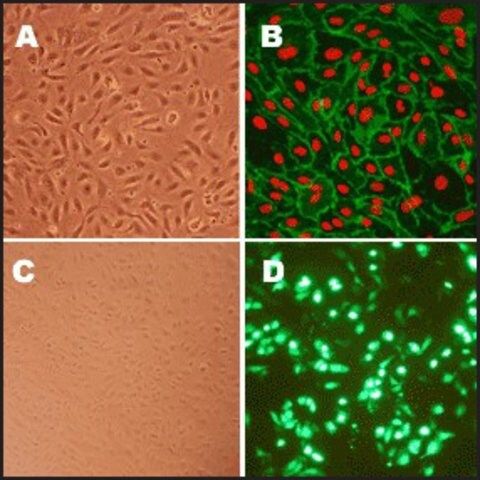您的位置:首页 > 产品中心 > Human Aortic Endothelial Cells: HAOEC, adult
Human Aortic Endothelial Cells: HAOEC, adult

基本信息
| NACRES | NA.81 |
| General description【一般描述】 | Human Aortic Endothelial Cells (HAOEC) provide an excellent model system to study all aspects of cardiovascular function and disease, and they have been utilized in dozens of research publications to study diabetes-associated complications related to cardiovascular function, investigate mechanisms of immune response and graft rejection, study endothelial dysfunction caused by air pollution, oxidative stress and inflammation, and develop 3d endothelialized engineered tissues, as well as new technologies based on novel material surfaces and drugs in order to reduce risks associated with vascular implants. Select HAOEC lots have been additionally tested to demonstrate stimulation-dependent angiogenesis and key endothelial cell signaling pathways (phosphorylation of VEGFR, Akt, MAPK, and expression of Tie2, eNOS, Axl and Etk/Bmx). HAOEC from Cell Applications, Inc. have been used to:
Additionally, HAOEC, along with human subclavian artery (HScAEC), carotid artery (HCtAEC), coronary artery (HCAEC) and brachiocephalic artery (HBcAEC) have been used to demonstrate that not only blood vessels from different tissues are highly heterogeneous, they also interact differently with leukocytes during the inflammation response (Scott, 2013). The authors further showed that differential N-glycosylation of commonly expressed vascular adhesion molecules may be responsible for this heterogeneity, as well as for modulation of signaling under resting and activated inflammatory conditions. This also explains why specific vascular beds may be more or less susceptible to particular diseases or stimuli. Importantly, if cells from different sources were used, these results could not be convincingly validated due to a number of uncontrolled variables, such as age, race, genetic variability or life style choices of the donors. Because of the complex heterogeneity that exists not only between different donors, but even between different vascular beds in the same individual, it would be prudent to confirm any new findings on primary cell lots coming from several different origins. |
| Cell Line Origin【细胞系来源】 | Aorta |
| Application【应用】 | cardiovascular function, studies on immune system and graft rejection, development of 3D endothelialized engineered tissues, drug discovery, stent-graft compatibility testing |
| Components【组分】 | Basal Medium containing 10% FBS & 10% DMSO |
| Preparation Note【制备说明】 |
|
| Subculture Routine【传代培养常规】 | Please refer to the HAOEC Culture Protocol. |
产品性质
| Quality Level【质量水平】 | 100 |
| biological source【生物来源】 | human aorta |
| packaging【包装】 | pkg of 500,000 cells |
| growth mode【生长模式】 | Adherent |
| karyotype【核型】 | 2n = 46 |
| morphology【形态学】 | Endothelial |
| technique(s) | cell culture | mammalian: suitable |
| relevant disease(s)【相关疾病】 | diabetes; cardiovascular diseases |
| shipped in【运输】 | dry ice |
| storage temp.【储存温度】 | −196℃ |
安全信息
| Storage Class Code【储存分类代码】 | 13 - Non Combustible Solids |
| WGK | WGK 3 |





